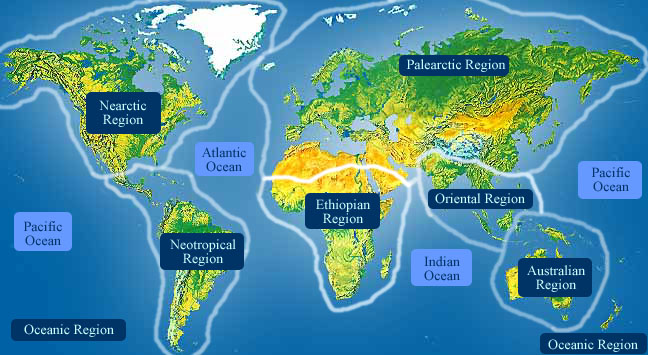Genetta genettacommon genet(Also: small-spotted genet)
Geographic Range
The common or European genet is native to northern Africa and has also spread to Europe.
- Biogeographic Regions
- palearctic
- ethiopian
Habitat
Common genets prefer drier areas than other members of the genus. They prefer forests, as they are excellent and agile climbers.
- Terrestrial Biomes
- savanna or grassland
- forest
- scrub forest
Physical Description
Genets are long, lean carnivores with a tail usually at least as long as the body. They appear catlike, except for their longer faces. They usually have a dark spotted or marbling pattern over a cream to buff colored background. Their fur is incredibly soft. They have semi-retractable claws. They are extremely flexible and can enter very small spaces.
- Other Physical Features
- endothermic
- bilateral symmetry
-
- Range mass
- 1 to 3 kg
- 2.20 to 6.61 lb
Reproduction
Genet females come into heat during the wet season(s). Copulation, which follows a foreplay lasting up to an hour, takes only five minutes, during which both the male and the female utter "meows." Gestation is usually 10-11 weeks long, and the female usually gives birth to one to three kittens. Young are born blind and helpless. They are weaned around eight weeks, though they take small amounts of solid food before that. Kits are sexually mature at two years.
- Key Reproductive Features
- gonochoric/gonochoristic/dioecious (sexes separate)
- sexual
Lifespan/Longevity
-
- Average lifespan
Status: captivity - 21.6 years
- Max Planck Institute for Demographic Research
- Average lifespan
-
- Average lifespan
Status: captivity - 14.0 years
- Max Planck Institute for Demographic Research
- Average lifespan
-
- Average lifespan
Sex: female
Status: captivity - 13.0 years
- Max Planck Institute for Demographic Research
- Average lifespan
-
- Average lifespan
Status: captivity - 34.0 years
- Max Planck Institute for Demographic Research
- Average lifespan
Behavior
Genets are primarily solitary animals, though male and female ranges may overlap. Individuals of the same sex have exclusive territories. They are nocturnal and only rarely appear during the day, though they are sometimes reported as foraging at twilight.
They are stealth hunters, much like the cats and kill with a quick bite to the neck. Their sharp claws both allow them to pin prey and to be excellent climbers.
- Key Behaviors
- motile
Communication and Perception
Food Habits
Genets are carnivorous and eat most small animals that they can catch, such as rats, mice, insects, small reptiles, and birds.
Economic Importance for Humans: Positive
Genets help keep vermin populations down, and since they often live on the edges of a human community, this helps alleviate pest problems with crops.
Economic Importance for Humans: Negative
Genets occasionally consume game birds and poultry, but hardly do enough damage to be considered a threat to either.
Conservation Status
The common genet is still plentiful throughout its range and seems to have little to fear in the future.
-
- IUCN Red List
-
Least Concern
More information
-
- IUCN Red List
-
Least Concern
More information
-
- CITES
- No special status
Other Comments
The viverrids are commonly regarded as the closest living mammals to the extinct common ancestor of the carnivores. Although the genets are very catlike, they also display some primitive features of this ancestor, making them an interesting study for people interested in carnivore evolution. It is suggested that others interested in this topic also research the civets, palm civets and linsangs for more information on viverrids.
Contributors
Barbara Lundrigan (author), Michigan State University, Molly Conley (author), Michigan State University.
Glossary
- Ethiopian
-
living in sub-Saharan Africa (south of 30 degrees north) and Madagascar.

- Palearctic
-
living in the northern part of the Old World. In otherwords, Europe and Asia and northern Africa.

- bilateral symmetry
-
having body symmetry such that the animal can be divided in one plane into two mirror-image halves. Animals with bilateral symmetry have dorsal and ventral sides, as well as anterior and posterior ends. Synapomorphy of the Bilateria.
- chemical
-
uses smells or other chemicals to communicate
- endothermic
-
animals that use metabolically generated heat to regulate body temperature independently of ambient temperature. Endothermy is a synapomorphy of the Mammalia, although it may have arisen in a (now extinct) synapsid ancestor; the fossil record does not distinguish these possibilities. Convergent in birds.
- forest
-
forest biomes are dominated by trees, otherwise forest biomes can vary widely in amount of precipitation and seasonality.
- motile
-
having the capacity to move from one place to another.
- native range
-
the area in which the animal is naturally found, the region in which it is endemic.
- scrub forest
-
scrub forests develop in areas that experience dry seasons.
- sexual
-
reproduction that includes combining the genetic contribution of two individuals, a male and a female
- tactile
-
uses touch to communicate
- tropical savanna and grassland
-
A terrestrial biome. Savannas are grasslands with scattered individual trees that do not form a closed canopy. Extensive savannas are found in parts of subtropical and tropical Africa and South America, and in Australia.
- savanna
-
A grassland with scattered trees or scattered clumps of trees, a type of community intermediate between grassland and forest. See also Tropical savanna and grassland biome.
- temperate grassland
-
A terrestrial biome found in temperate latitudes (>23.5° N or S latitude). Vegetation is made up mostly of grasses, the height and species diversity of which depend largely on the amount of moisture available. Fire and grazing are important in the long-term maintenance of grasslands.
References
Grzimek, B. 1990. Grzimek's Encyclopedia of Mammals. New York; New York: McGraw Hill.
Nowak, R. 1999. Walker's Guide to Mammals. Baltimore; MD: Johns Hopkins Press.
O'Callaghan, P. 1971. Tiki: Our Genet Cat. New York; NY: Simon and Schuster.
